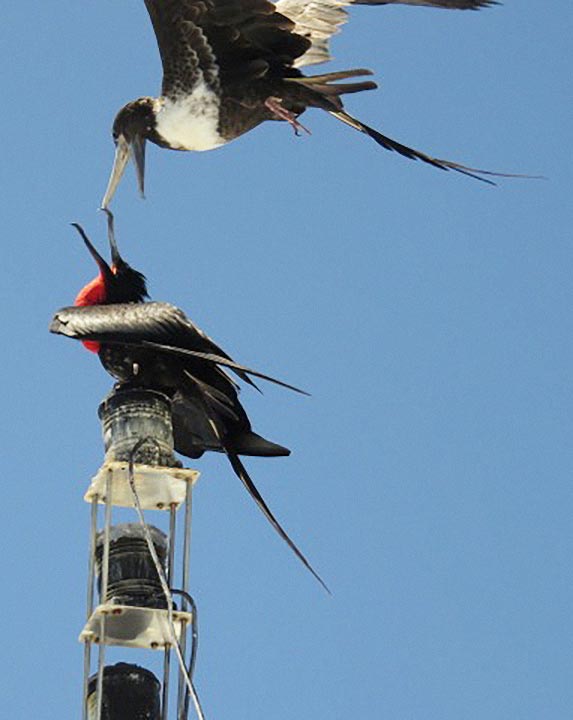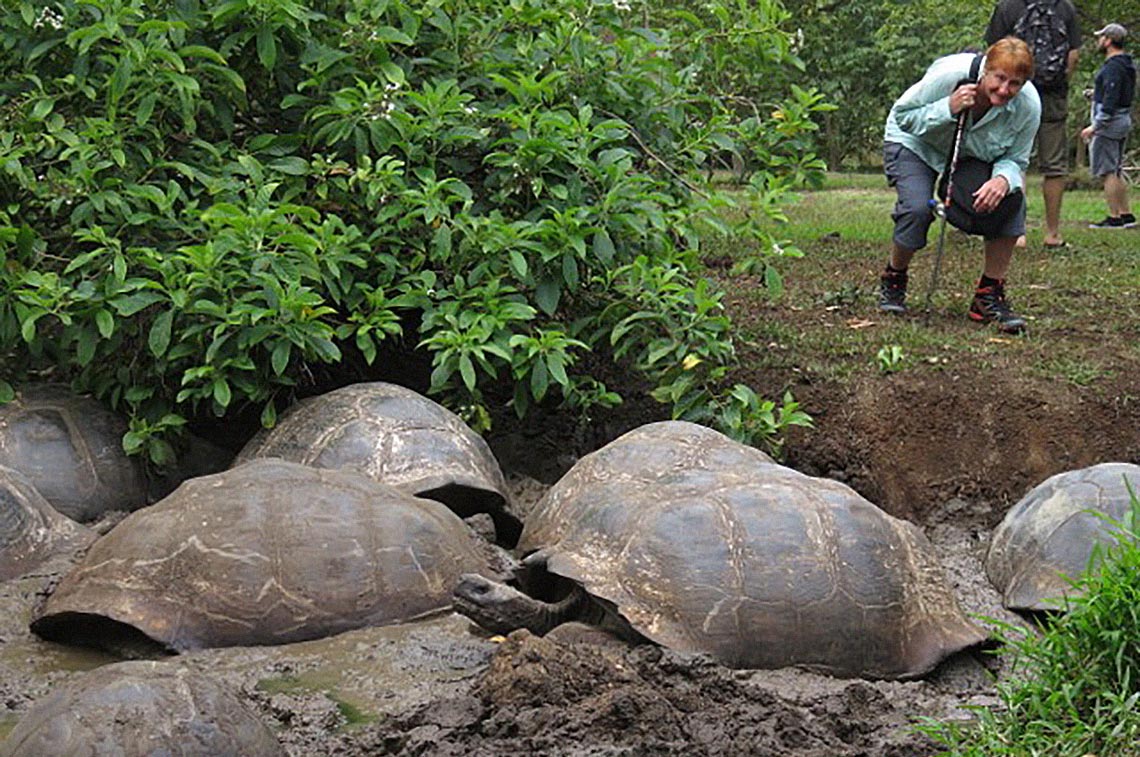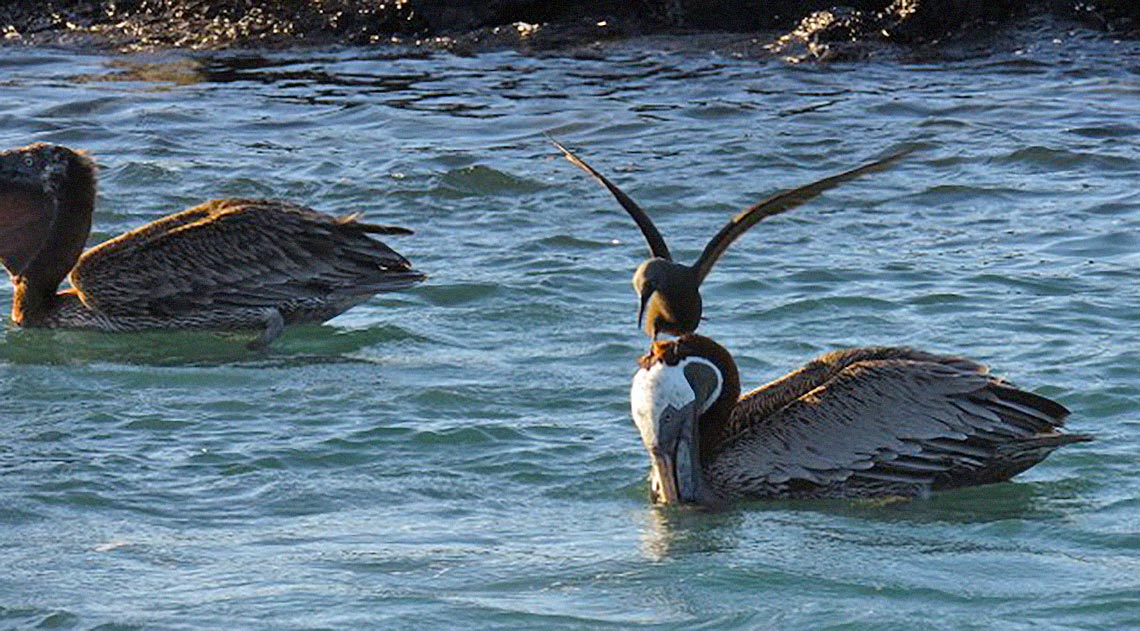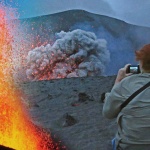The Amazing Galapagos Islands through the eyes of Dr Anne Small
At last our centre’s founder, Dr Anne Small, has reached the Galapagos and spied her first Blue Footed Booby and there’s plenty more where that came from!
Following in the footsteps of Charles Darwin
Advice to travellers – you need $US100 per person to enter the Galapagos and the one ATM machine is on the other side of the Customs section to which you pay the money. I had to borrow some cash from people we had just met on the bus/plane coming on our tour – otherwise I couldn’t have entered!

One of the blue-footed boobys we saw, taking flight from the water
That afternoon I saw my first Blue Footed Booby – I love the name and have wanted to see one for decades. It looks like a seagull with a more pointed beak and blue feet. They dive like terns deep into the water for fish. They dive straight down, while the brown (not white) pelicans dive at an angle. There are wingless cormorants which have feathered stumps for wings but they are wonderfully adapted to dive up to 300 feet to find fish and squid to eat. This afternoon I finally saw the Galapagos penguins – there are not many of them and they are only on the west side of Galapagos and we are moving later to the east side.
These amazing islands – of which there are 13 major ones and 100 or so small ones, less than two square kilometres – have been formed by the eruption of land when the two major tectonic plates hit one another.

Dr Anne Small descends into the depths towards a Galapagos Island green turtle

The twisted remnants of a once-molten landscape
Isabella Island is the largest and is on the West side – they call it the ‘hot spot’ because this is where most of the volcanic activity is happening. The last volcanic eruption was only two months ago! There is an area around Urbina Bay (in Isabella Island) that was pushed up from the sea bed to now stand five metres above sea level and this only happened in the mid-1950s!
The islands are being pushed South East at a measured rate of 5cm/year and are sinking on their East sides at 3-5cm/year. So the islands are born from volcanic eruptions in the West and die in the East.
Each island has its own specific vegetation and animals – no wonder Charles Darwin (who came here in 1835) had such a spectacular scientific study. At Urbina Bay there is a poisonous (to humans) apple tree that the Giant Tortoises feast upon and which is found nowhere else here. Now a lot of the islands are brown with dead looking trees because it is summer but around December when it rains, it becomes green and the trees look alive again.
Adapt Or Die!

Galapagos frigate birds
The message to the animals is adapt or die, so the grey/black marine iguanas live off the ocean while the yellow/orange land iguanas feed of the land. We have only seen one giant tortoise which was a baby but it still stood about 30sm tall – they have adapted such that they can go for 12 months with no food or water.
We have seen many green Pacific sea turtles and we actually swam with them. We snorkel once or twice a day – the fish are colourful, but not as many as in Australia and no colourful coral.
Lava flows look as fresh as yesterday
On Isabella Island there are five volcanoes which last erupted in 2005, 2009, and a few months ago, so you can see where the lava flowed down into the sea and you can see their craters standing high up above the sea.

One of the many marine iguanas we saw
It took me a few days of hearing about the ‘hot spot’, the islands being formed and moving south East ad their unique and different vegetation and animals to realise a trip to the Galapagos is more about evolution and unique adaption than about the animals.
We visited Sullivan Bay on Santiago Island where we walked on huge lava flows that looked like they had been made yesterday – but yesterday is estimated to be one million years ago. The formation patterns in the lava are amazing.

The amazing views across the volcanic footings to the blue sea
Giant Tortoises aplenty!
On the last day we went to El Chato Ranch, a reserve where we saw lots of giant tortoises!! – some were 150 YEARS OLD – lounging in their mud ponds or grazing on the grass in the paddocks next to the cows!

Checking out the ancient, yet very much alive, giant tortoises.

Diving with green turtles
Seeing all these wonderful majestic creatures being cared for so they won’t become extinct was a fitting way to end an amazing informative tour. I recommend the great BBC documentaries on the Galapagos … they are very educational with fabulous photography.
Now it’s back to Quito … hope there are no more earthquakes! Then to Lima, to Santiago for a few days to rest and integrate all these extraordinary experiences over the last month, and then home. Hope you have enjoyed this blog and see you all soon,
Love Anne
 Galapagos iguana – more images from Anne’s camera below
Galapagos iguana – more images from Anne’s camera below













